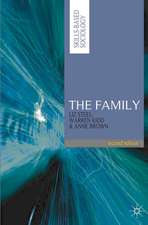Family Issues on Marriage, Divorce, and Older Adults in Japan: With Special Attention to Regional Variations
Autor Fumie Kumagaien Limba Engleză Hardback – 30 oct 2014
By emphasizing the extensive cultural diversity from one region to another, this book represents a paradigm shift from former studies of Japanese families, which relied mostly on national average data. The method of analysis adopted in the study is qualitative, with a historical perspective. The book is thus an invitation to more in-depth, qualitative dialogue in the field of family sociology in Japan.
This book will be of great interest not only to Asian scholars, but also to other specialists in comparative family studies around the world.
| Toate formatele și edițiile | Preț | Express |
|---|---|---|
| Paperback (1) | 382.95 lei 6-8 săpt. | |
| Springer Nature Singapore – 22 sep 2016 | 382.95 lei 6-8 săpt. | |
| Hardback (1) | 390.25 lei 6-8 săpt. | |
| Springer Nature Singapore – 30 oct 2014 | 390.25 lei 6-8 săpt. |
Preț: 390.25 lei
Nou
Puncte Express: 585
Preț estimativ în valută:
74.68€ • 77.53$ • 62.27£
74.68€ • 77.53$ • 62.27£
Carte tipărită la comandă
Livrare economică 22 martie-05 aprilie
Preluare comenzi: 021 569.72.76
Specificații
ISBN-13: 9789812871848
ISBN-10: 9812871845
Pagini: 150
Ilustrații: XIX, 184 p. 54 illus., 32 illus. in color.
Dimensiuni: 155 x 235 x 17 mm
Greutate: 0.47 kg
Ediția:2015
Editura: Springer Nature Singapore
Colecția Springer
Locul publicării:Singapore, Singapore
ISBN-10: 9812871845
Pagini: 150
Ilustrații: XIX, 184 p. 54 illus., 32 illus. in color.
Dimensiuni: 155 x 235 x 17 mm
Greutate: 0.47 kg
Ediția:2015
Editura: Springer Nature Singapore
Colecția Springer
Locul publicării:Singapore, Singapore
Public țintă
ResearchCuprins
List of Figures.- List of Tables.- Preface.- Chapter 1: Introduction: A New View on Changes in Japanese Families.- 1.1: Two Theoretical Frameworks for the Study of Family Issues in Japan.- 1.2: A Dual Structural Model of the Japanese Family-The Modified Stem.- Family.- 1.3: Regional Variations by Prefecture: Haihan Chiken (Dissolution of Domains and Establishment of Prefectures).-1.4: Data and Methods.- 1.4.1: Data.- 1.4.2: Analytic Strategy.- 1.5: Family Issues to Be Discussed.- References.- Chapter 2: Demographic Changes in Japan.- 2.1: Introduction.- 2.2: Changes in the Japanese Household Structure — the Nuclear Family.- 2.3: Changes in the Three-Generation Family.- 2.4: Family Size: Changes and Projections for the Average Number of Persons in a Household by Prefecture.- 2.5: Demographics of the Japanese Elderly.- 2.5.1: The Graying of Japan — Population Aging and Fertility Decline.- 2.5.2: Declining Birth Rates and Total Fertility Rates (TFR).- 2.5.3: The Baby Boomer Generations.- 2.5.4: The Longevity Revolution: Rising Life Expectancy.- 2.5.5: Aging of the Elderly Population.- 2.5.6: Marital Status of Japanese Elderly.- 2.5.7: Japanese Elderly and Family Relations.- 2.6: Living Arrangements of the Elderly.- 2.6.1: With Family.- 2.6.2: Problems Associated with Coresidency Living Arrangements.- 2.7: Regional Variations of the Japanese Elderly.- 2.8: Conclusion.- References.- Chapter: 3: History of Courtship and Marriage in Japan.- 3.1: Historical Perspective.- 3.1.1: Primitive Times of Jyomon and Yayoi: BC 12,000–AD 240.- 3.1.2: Yamato (Tumulus) Era: from the 3rd to the 6th Century.- 3.1.3: Asuka – Early Heian: 593-1000.- 3.1.4: Mid-End Heian Period.- 3.1.5: End Heian Period: The end of 11th to the end of the 12th century.- 3.1.6: Kamakura Shogunate and Nanboku-cho: 1192-1333-1336.- 3.1.7: Muromachi Shogunate – Edo Shogunate.- 3.1.8: Meiji – Taisho – Showa –Present (Heisei): Yoriai-kon.- 3.2: Attitudes toward Marriage and Mate Selection.-3.2.1: Miai-kekkon and Ren-ai-kekkon.- 3.2.2: High Ages at First Marriage and the Delayed Marriage.- 3.2.3: Life-time Singlehood.- 3.2 4: Live Births to Unmarried Mothers.- 3.2.5: De facto Partnerships: Cohabitation.- 3.2.6: Roles and Functions of the Nakoudo: the traditional vs. the new.- 3.3: The Current Situation.- 3.3.1: Commercial Matchmaking/Dating Agency.- 3.3.2: Matchmaking by Local Communities and/or Municipal Offices.- 3.3.3: Machi-kon, the Town Based Marriage-meeting Events.- 3.4: Conclusion: Kon-katsu.- References.- Chapter 4: International Marriage in Japan: A Strategy to Maintain Rural Farm Households.- 4.1: Introduction.- 4.1.1: Two Opposing Views on International Marriage.- 4.1.2: International Marriage as a New Way to Maintain Rural Farm.- Households.- 4.2: International Marriage in Japan.- 4.2.1: Historical Development.- 4.2.2: Demographic Features of International Marriages: Foreign Brides versus Foreign Grooms.- 4.3: Regional Variations of International Marriages by Prefecture.- 4.3.1: International Marriages: Percentage of Total.- 4.3.2: Japanese Wife/Foreign Husband: Percentage of Total.- 4.3.3: Japanese Husband/Foreign Wife: Percentage of Total.- 4.4: Yamagata Prefecture-Pioneering Prefecture for International Marriage in Japan Today.- 4.4.1: Foreign Residents in Yamagata Prefecture.- 4.4.2: Nationalities.- 4.4.3: Correlation between Number of Foreigners and Household Type by Municipality.- 4.4.4: A Brief History of Foreign Brides in Yamagata Prefecture.- 4.4.5: Asahi-machi.- 4.4.6: Tozawa-mura.- 4.5: Three Reports on Research into Family Relations in Yamagata Prefecture.- 4.5.1: “Survey Report on the Attitudes toward Families in Yamagata Prefecture” (Association for International Relations in Yamagata: AIRY, 2006).- 4.5.2: “Report on the Questionnaire Survey Research on Foreigners Residing in Yamagata Prefecture” (Association for International Relations in Yamagata: AIRY, 2011).- 4.5.3:Yamagata Prefecture Bureau of InternationalEconomic Exchange (2014).- 4.6: Conclusion.- References.- Chapter 5: Changing Divorce in Japan: With Special Attention to Regional Variations.- 5.1: Introduction.- 5.2: A Brief History of Divorce in Japan.- 5.2.1: The First Period: 1883–1897.- 5.2.2: The Second Period: 1898–1899.- 5.2.3: An Overview of Japanese Divorce: 1960 to 2013.- 5.3: Three Conspicuous Characteristics of Divorce in Japan.- 5.3.1: Duration of Marriage before Divorce.- 5.3.2: Child Custody in Divorce.- 5.3.3: Divorce by Mutual Agreement.- 5.4: Regional Variations in Divorce.- 5.5: Some Cultural Explanation of Divorce in Japan.- 5.5.1: Prefectures with Low Divorce Rates Today: Niigata and Shimane.- 5.5.2: Prefectures with High Divorce Rates Today: Hokkaido, Okinawa, Osaka, Fukuoka, Miyazaki, and Kochi.- 5.6: Conclusion.- References.- 6: Late-Life Divorce in Japan Revisited: Effects of the Old-age Pension Division Scheme.- 6.1: Introduction.- 6.2: Recent Changes in Divorce in Japan.- 6.3: Duration of Marriage Prior to Divorce.- 6.4: Late-Life Divorce and the Year 2007 Issue.- 6.5: Baby Boomers and the Duration of Marriage at the Time of Divorce.- 6.6: Higher Divorce Rate among Younger Couples over Veteran Couples.- 6.7: Reasons for Late-Life Divorce.- 6.7.1: Divorce by Mutual Agreement or by Judicial Procedure.- 6.7.2: Reasons for Divorce.- 6.7.3: Motives for Late-Life Divorce.- 6.8: Conclusion.- References.- Chapter 7: Japanese Elders Living Apart: Policy Suggestions.- 7.1: Introduction.- 7.2: Living Arrangements of the Elderly: Living Alone Households.- 7.2.1: Family Size.- 7.2.2: Living Alone Households by Sex and by Age-Group.- 7.2.3: Proportions of the Household Type in which the Elderly Sixty-Five and Over Reside by Prefecture.- 7.2.4: Elderly-Headed Households.- 7.2.5: Living Alone Households of Japanese Elderly by Sex.- 7.2.6: Elderly Living Alone Households of the Total Elderly-Headed Households.- 7.2.7: Elderly 75 and Over-Headed Households.- 7.3: Yamagata and Kagoshima Prefectures.-7.3.1: Yamagata Prefecture.- 7.3.2: Kagoshima Prefecture.- 7.3.3: Yamagata: High Rate of Coresidency and Low Rates of Elderly One and Two-Person Households.- 7.3.4: Kagoshima: High Rate of Elderly Living Alone Households.- 7.4: Successful Aging of Japanese Elders Living Alone.- 7.4.1: Measurements of Successful Aging.- 7.4.2: Five Major Factors.- 7.4.3: Elders Living Alone: Yamagata Prefecture.- 7.4.4: Elders Living Alone: Kagoshima Prefecture.- 7.4.5: Elders Living Alone: Tokyo Metropolitan Area: Minato Ward.- 7.5: Policy Recommendations for the Elderly Living Alone.- 7.6: Conclusion.- References.- Chapter 8: Conclusion - Toward Globalization of Japanese Families.- 8.1: Toward Globalization through the Field of Family Sociology.- 8.2: Summary of Major Findings, Implications and Limitations of the Book.- 8.3: Relating the Dual Structural Model to the Family Issues Discussed.- 8.4: The Future of Japanese Families.- 8.4.1: Japanese Families in the Era of Population Decline.- 8.4.2: Japanese Families with Working Mothers.- 8.4.3: Japanese Families and Global Cooperation.- 8.5: Japan as a Global Partner.- References.- Index.
Notă biografică
Fumie Kumagai is a Japanese sociologist holding an American doctorate, with extensive experience in the West as a student, college professor and researcher. Her overseas experience affords her a unique cross-cultural perspective in the field of families and demography, social issues, and intercultural communication. In discussing Japanese society, culture, and families, she pays close attention to regional variations rather than taking Japan as a whole. Since her return to Japan, Professor Kumagai has been Professor of Sociology with the Graduate School of International Cooperation and the Department of Foreign Studies at Kyorin University in Tokyo, and is currently Professor Emeritus of Kyorin University. Although she no longer carries out regular teaching duties, she continues to conduct research and writings. She feels that a part of the invisibility of Japan comes from its inability to express itself clearly in the international community. In order to address the situation, Professor Kumagai is eager to exchange dialogue with the ever progressing global society about the true nature of Japan.
Textul de pe ultima copertă
This book provides insightful sociological analyses of Japanese demography and families, paying attention not only to national average data, but also to regional variations and community level analyses. In analyzing Japanese family issues such as demographic changes, courtship and marriage, international marriage, divorce, late-life divorce, and the elderly living alone, this book emphasizes the significance of two theoretical frameworks: the dual structure and regional variations of the community network in Japan.
By emphasizing the extensive cultural diversity from one region to another, this book represents a paradigm shift from former studies of Japanese families, which relied mostly on national average data. The method of analysis adopted in the study is qualitative, with a historical perspective. The book is thus an invitation to more in-depth, qualitative dialogue in the field of family sociology in Japan.
This book will be of great interest not only to Asian scholars, but also to other specialists in comparative family studies around the world.
By emphasizing the extensive cultural diversity from one region to another, this book represents a paradigm shift from former studies of Japanese families, which relied mostly on national average data. The method of analysis adopted in the study is qualitative, with a historical perspective. The book is thus an invitation to more in-depth, qualitative dialogue in the field of family sociology in Japan.
This book will be of great interest not only to Asian scholars, but also to other specialists in comparative family studies around the world.
Caracteristici
Approaches Japanese demography and families from a regional variation perspective Challenges Japanese family issues through the dual perspective of traditional and modern natures Builds on demography and families in Japan from historical, cultural, and qualitative perspectives Contributes a Japanese perspective to understanding of the Japanese family Includes supplementary material: sn.pub/extras










